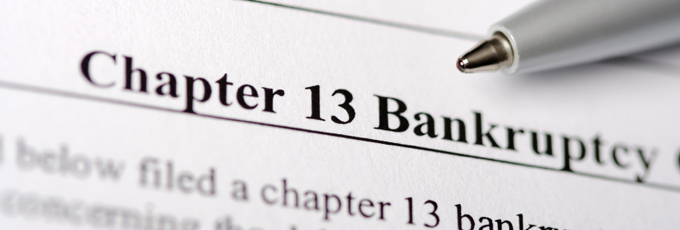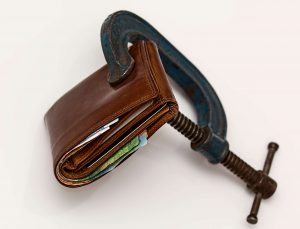 Chapter 13 bankruptcy, better known as a wage earner’s plan enables individuals with regular income to develop a plan to repay all or part of their debts. Under Chapter 13, debtors propose a repayment plan to make monthly installments to creditors over a three to five year period. If the debtor’s monthly income is less than the applicable state median the plan will be for three years unless the court approves a longer period. If the debtor’s current monthly income is greater than the applicable state median, the plan generally must be for five years. In no case may a plan provide for payments over a period longer than five years. During this time the law forbids creditors from starting or continuing collection efforts.
Chapter 13 bankruptcy, better known as a wage earner’s plan enables individuals with regular income to develop a plan to repay all or part of their debts. Under Chapter 13, debtors propose a repayment plan to make monthly installments to creditors over a three to five year period. If the debtor’s monthly income is less than the applicable state median the plan will be for three years unless the court approves a longer period. If the debtor’s current monthly income is greater than the applicable state median, the plan generally must be for five years. In no case may a plan provide for payments over a period longer than five years. During this time the law forbids creditors from starting or continuing collection efforts.
The following account will discuss the advantages of choosing Chapter 13, the Chapter 13 eligibility requirements and how a Chapter 13 proceeding typically works.
Advantages of Chapter 13
Chapter 13 offers individuals a multitude of advantages compared to the liquidation under Chapter 7 bankruptcy. Most significant, Chapter 13 offers individuals an opportunity to save their homes from foreclosure proceedings.
When an individual files for Chapter 13, foreclosure proceedings stop and may cure the delinquent payments over a period of time. Regardless, all mortgage payments that come due during the court proceedings must be paid on time.
Another advantage of Chapter 13 bankruptcy is that it allows for rescheduling of secured debts and extends them over the life of the Chapter 13 plan. Rescheduling these debts may result in lowered payments.
Chapter 13 also contains a special provision to protect third parties such as co-signers.
Finally, Chapter 13 essentially acts as a consolidation loan under which plan payments are made directly to the Chapter 13 trustee who then distributes payments to the creditors. During this time the debtor will have no direct contact with creditors while under the protection of Chapter 13.
Chapter 13 Eligibility
Any individual even those who are self-employed or operating under an unincorporated business is eligible for Chapter 13 relief as long as the individual’s unsecured debts are less than $394,725 and unsecured debts are under $1,184,000. A corporation or partnership may not be a chapter 13 debtor.
Special circumstances such as a prior bankruptcy petition dismissal due to the debtor’s willful failure to appear before the court or comply with orders of the court or voluntary dismissal during the proceeding 180 days may result in ineligibility.
In addition to the previous, no individual may be a debtor under any chapter of the Bankruptcy Code unless he or she has, within 180 days prior to filing, received the appropriate credit counseling from a credit counseling agency either in an individual or group briefing.
There are however exceptions during emergency situations or where the U.S. trustee has determined there are insufficient agencies to provide the appropriate counseling. If a debt management plan is developed during the required counseling it must be filed with the court.
How Chapter 13 Works
A Chapter 13 case begins by filing the appropriate petition with the bankruptcy court in a location where the debtor has a residence. Unless the court orders otherwise the debtor must also file the following with the court.
- A schedules of assets and liabilities;
- A schedule of current income and expenditures;
- A schedule of executory contracts and unexpired leases; and
- A statement of financial affairs.
The debtor must also file a certificate of credit counseling and a copy of any debt repayment plan developed through credit counseling; evidence of payment from employers, if any, received 60 days before filing; a statement of monthly net income and any anticipated increase in income or expenses after filing; and a record of any interest the debtor has in federal or state qualified education or tuition accounts.
The debtor must provide the chapter 13 case trustee with a copy of the tax return or transcripts for the most recent tax year as well as tax returns filed during the case.
A husband and wife may file a joint petition or individual petitions.
In order to complete the Official Bankruptcy Forms that make up the petition, statement of financial affairs, and schedules, the debtor must compile the following information:
- A list of all creditors and the amounts and nature of their claims;
- The source, amount, and frequency of the debtor’s income;
- A list of all of the debtor’s property;
- A detailed list of the debtor’s monthly living expenses, i.e., food, clothing, shelter, utilities, taxes, transportation, medicine, etc.
Married individuals must gather this information for their spouse regardless of whether they are filing a joint petition, separate individual petitions, or even if only one spouse is filing. In a case where only one spouse is filing, the court will require the income and expenses of the other spouse in order to evaluate the accurate household’s financial position.
When an individual files this type of petition, a trustee is appointed to administer the case. The Chapter 13 trustee will evaluate the case and serve as a disbursing agent to collect payments from the debtor as well as distribute payments to the creditors.
When an individual files a Chapter 13 petition most collection actions against the debtor and the debtor’s properties are automatically stopped. Filing the petition does not stop certain types of actions and the stay may be effective only for a brief time.
The stay operates under the law and requires no judicial action. As long as the stay is in effect, most creditors will not initiate or continue lawsuits, wage garnishments and make telephone calls demanding payments. As long as the debtor provides a full list of creditors including names and address to the bankruptcy clerk, those creditors will be notified.
In regard to foreclosures, Chapter 13 may be useful to save the home. As soon as an individual files the Chapter 13 petition, the automatic stay will stop the foreclosure proceedings. The debtor will then be able to bring the past-due payments current over a period of time.
However, the debtor may still lose the home if the mortgage company completes the foreclosure sale under the state law before the petition is filed. The debtor may also lose the home if there is a failure to make the regular mortgage payments that come due after the Chapter 13 filing.
A meeting will be held by the Chapter 13 trustee with the creditors approximately 21 to 50 days after the debtor has filed the petition. If the meeting is scheduled at a place that does not have regular U.S. trustees or bankruptcy administrator staffing the meeting may be held no more than 60 days after the petition is filed.
During the meeting, the debtor is placed under oath by the trustee. While the debtor is under oath, the trustee and creditors may ask questions. The debtor must attend the meeting and answer questions regarding their financial affairs as well as the proposed terms of the plan.
Any problems that arise are typically resolved either during or shortly after the creditors meeting. Generally, the debtor can avoid problems by ensuring the petition and plan is not only complete but also accurate. The trustee can be consulted prior to the meeting by the debtor to ensure accuracy.
After the meeting of creditors, the debtor, the chapter 13 trustee, and those creditors who wish to attend will come to court for a hearing on the debtor’s chapter 13 repayment plan.
Final Thoughts
While a Chapter 13 bankruptcy may seem like a lot of paperwork, which it is, it can be handled more efficiently by hiring a bankruptcy attorney such as Brent M. Myer, PLLC. Having an attorney present will allow the debtor to feel secure in the bankruptcy proceedings.
The Law Office of Brent M. Myer, PLLC offers free consultations for individuals considering bankruptcy. Give us a call at (772) 873-7494 to schedule your consultation today!



